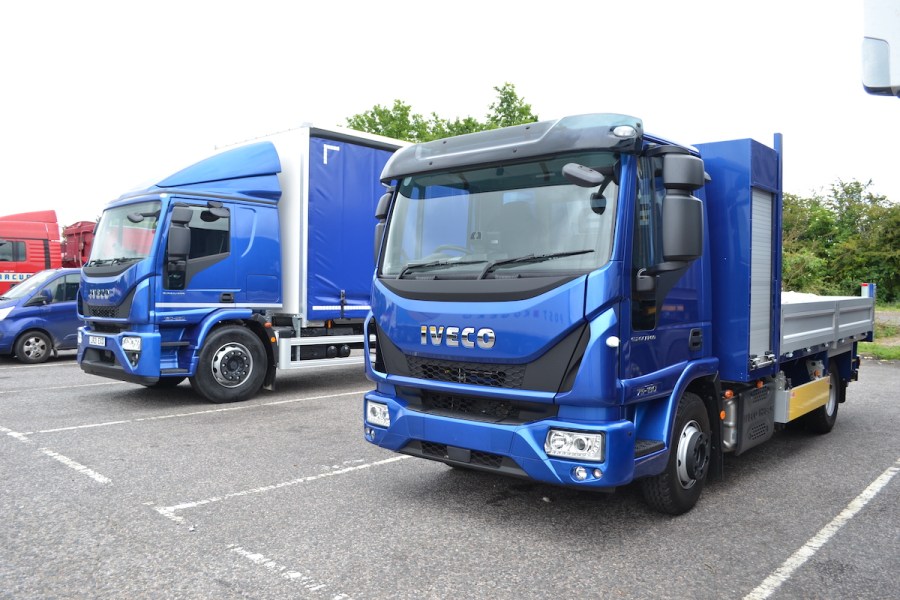It might be showing its age next to newer competing vehicles, but Iveco’s Eurocargo still offers hard graft at a reasonable price. We take 7.5- and 18-tonne variants for a tour around Oxfordshire to see how they perform.
Arguably, Iveco has had a rough time in the UK market, but its fortunes finally seem to be turning with its new S-WAY. Despite the previous Stralis long-hauler being a decent and capable truck, it failed to catch much of a hold on this side of the Channel.
However, it seems British operators’ interest in S-WAY is much keener. Finally, the Italian manufacturer has a truck that looks like a fleet flagship – but with the recent release of other competing models such as MAN’s TG range and DAF’s just-unveiled next-gen XG, XG+ and XF, S-WAY has a fight on its hands going forwards.
That said, Iveco has a tradition of offering a lot of truck for the money – so savvy hauliers wanting to maximise earning potential would do well to keep them on their radar.
The new S-WAYs are all well and good, but what’s on offer for lower-weight distributors? Well, moving down the weight range, Iveco’s Eurocargos have proven a cost-effective choice for hauliers chasing profit in the lighter-weight sector – but they’ve been around for a while and are starting to show their age.
Choices, choices…
Eurocargos can be spec’d from 7.5 to 18 tonnes. Though the bottom seems to have fallen out of the 7.5-tonne market in this country (for maximum payload, it can make more sense to spec a large van instead), there’s still a role for them in some lines of work.
Launched back in 2015 as ‘the truck the city likes’, Eurocargo is mirrored on the stylings of Iveco’s Daily and has a ‘smiley’ front end which is supposed to help its acceptance in urban areas (and once you’ve seen that grin, it can’t be unseen!).
Looks aside, Eurocargo has some advantages for urban operation. With a cab width of 2.1 m, it’s small enough to tuck into narrow streets and a steering angle of 52 degrees gives a tight turning circle. Three different cab types are available: MLC Day, MLL Sleeper with low or high roof, and MLD Crew.
Iveco is also offering a factory-fitted package that brings Eurocargo up to London’s Direct Vision Standard (DVS) one-star rating. This includes a vision window in the passenger door and proximity warning sensors.
Eurocargo buyers can choose from either four-cylinder, 4.5-litre Tector 5 or six-cylinder, 6.7-litre Tector 7 diesel engines. Combined, these offer seven power outputs from 160 bhp and 680 Nm torque, all the way up to 360 bhp and 1100 Nm torque. Gearbox options are six- or 12-speed automated; automatic with torque converter; or six- or nine-speed manual transmissions.
Another benefit of picking Eurocargo is Iveco’s unique HI-SCR aftertreatment system means there’s no time lost to regeneration. This is because the passive DPF is managed automatically by the vehicle, so the driver can just get on with deliveries without having to periodically wait while particulate matter is burned out of the system.
7.5-tonner
Recently, we were given the opportunity to take a 7.5-tonne and 18-tonne Eurocargo for a test drive around West Berkshire and South Oxfordshire to see what they can offer. Arriving at Chievely Services on an overcast June weekday, our first test vehicle was an ML75E19/K tipper with MLC Day Cab, built to a pretty basic spec – though it did have a few bits of additional kit including Hi-Comfort driver’s seat.
This truck had Iveco’s recent Euro 6d 4.5-litre Tector 5 rated at 190 bhp and pushing out 700 Nm of torque at
1100 rpm. We were loaded to 7250 kg on the nose with bags of gravel.
We had earmarked a trip around the local area taking in a mixture of A-roads, residential zones and town centres. Heading out of Chievely, we took the A34 for an 18-mile stretch towards Abingdon and immediately engaged cruise control. The truck had a ZF six-speed automated gearbox which isn’t really set up for cruising – it held onto gears for ages and sat at the very top of the green band in top gear. This meant the engine was working hard as we made our way to the Abingdon turn-off, and it was pretty noisy inside the cab as a result.
But this little tipper is far happier in and around town. Once we’d turned off the A34, we met the usual daytime traffic as we followed the river towards the busy town centre. The truck coped well with stop-start traffic lights and other hold-ups, and it was easy to feed it around the streets. Visibility was fine – not the best in its class, but aside from the usual blindspots, we didn’t feel it was too restricted.
Moving on through Radley and Kennington, we went around the Oxford bypass, joined the A40 and proceeded to our stop at Oxford Services, where we’d arranged to switch to the next test truck.
18-tonner
Our next drive was in an ML180E28/P rigid with curtainside body. This had a 6570 mm wheelbase and was packing the larger MLL Sleeper Cab with three-piece bunk. With a kerb weight of 6055 tonnes, this Eurocargo offers a payload of 11,945 kg. For our test, we were loaded to 17.2 tonnes.
Under the hood was the 6.7-litre Tector 7 motor at 280 bhp. At 15.5 bhp per tonne, this is plenty for a typical distribution run – but those who encounter more hills may want to consider the top-power 320 bhp lump.
Pulling out of Oxford Services, we went back onto the A40 towards Kiddlington. This Eurocargo had a 12-speed automated ’box and Adaptive Cruise Control, which gave a pleasant (and much quieter) cruise and coped well with the slow traffic around Oxford.
Again, we found the spec of this truck fairly pedestrian, but representative of what you might find on a fleet. There’s a decent amount of room in the cab and it feels big enough for the odd night out. As is typical with this generation of Iveco, the fit and finish is workmanlike, with chunky switches and hard-wearing upholstery. It’s not luxurious – but let’s be honest, few 18-tonners are spec’d for luxury.
After turning off and poking about a bit in Kiddlington, we rejoined the A34 to head south back down to Chievely Services. Though we didn’t encounter anything more arduous than a few roundabouts and traffic lights, this Eurocargo gave a pleasant drive. On-road manners are good and the cab is feels perfectly comfortable enough for a long day’s work.
Verdict
While it doesn’t present much of a challenge to the premium brands, Iveco has a lot to offer cost-conscious hauliers seeking a no-frills workhorse. These trucks are built to earn money – and if you’re not afraid to make a few concessions, they’ll do just that. Both of our test vehicles gave fine, if unspectacular drives (even though the 7.5-tonner was noisy). And if their plain interiors may seem a bit clunky, they’re easy to get to grips with and feel tough enough to go the distance.
But as we mentioned at the beginning of our review, recent range updates from other manufacturers are throwing shade over Iveco’s current lighter-weight vehicles. This generation of Eurocargo has been around for six years now – and it shows. Compared to MAN’s new TGM 18-tonner we drove last issue, Eurocargo is crying out for a refresh. An updated version must be just around the corner; but at the time of writing, Iveco is holding its cards close to its chest.
Likes:
- Easy to drive
- Comfortable cab
Dislikes:
- 7.5-tonner gives a noisy ride
- Range feels in need of refresh






